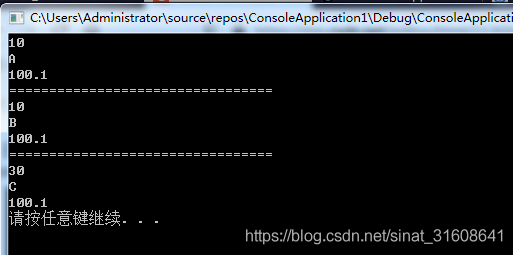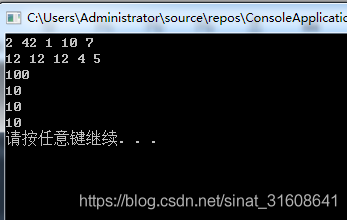一、介紹
C++11中提供了std::bind。bind()函數的意義就像它的函數名一樣,是用來綁定函數調用的某些參數的。
bind的思想實際上是一種延遲計算的思想,將可調用對象保存起來,然后在需要的時候再調用。而且這種綁定是非常靈活的,不論是普通函數、函數對象、還是成員函數都可以綁定,而且其參數可以支持占位符,比如你可以這樣綁定一個二元函數:
auto f = bind(&func, std::placeholders::_1, std::placeholders::_2);調用的時候通過f(1,2)實現調用。所以,我們可簡單的認為std::bind就是std::bind1st和std::bind2nd的加強版。
std::bind函數有兩種函數原型,定義如下:
template< class F, class... Args >
/*unspecified*/ bind( F&& f, Args&&... args );
template< class R, class F, class... Args >
/*unspecified*/ bind( F&& f, Args&&... args );Parameters
| f | - | Callable object (function object, pointer to function, reference to function, pointer to member function, or pointer to data member) that will be bound to some arguments |
| args | - | list of arguments to bind, with the unbound arguments replaced by the placeholders _1, _2, _3... of namespace std::placeholders |
二、實例
這里要先學習仿函數。請參考仿函數的使用
實例1
#include <iostream>
#include <functional>
using namespace std;
int TestFunc(int a, char c, float f)
{
cout << a << endl;
cout << c << endl;
cout << f << endl;
return a;
}
int main()
{
auto bindFunc1 = bind(TestFunc, std::placeholders::_1, 'A', 100.1);
bindFunc1(10); //等于TestFunc(10,'A', 100.1)
cout << "=================================\n";
auto bindFunc2 = bind(TestFunc, std::placeholders::_2, std::placeholders::_1, 100.1);
bindFunc2('B', 10); //等于TestFunc(10,'B', 100.1)
cout << "=================================\n";
auto bindFunc3 = bind(TestFunc, std::placeholders::_2, std::placeholders::_3, std::placeholders::_1);
bindFunc3(100.1, 30, 'C'); //等于TestFunc(30,'C', 100.1)
return 0;
} 
上面這段代碼主要說的是bind中std::placeholders的使用。 std::placeholders是一個占位符。當使用bind生成一個新的可調用對象時,std::placeholders表示新的可調用對象的第 幾個參數和原函數的第幾個參數進行匹配。
auto bindFunc3 = bind(TestFunc, std::placeholders::_2, std::placeholders::_3, std::placeholders::_1);
bindFunc3(100.1, 30, 'C');可以看到,在bind的時候,第一個位置是TestFunc,除了這個,參數的第一個位置為占位符std::placeholders::_2,這就表示,調用bindFunc3的時候,它的第二個參數——即30,和TestFunc的第一個參數匹配,所以std::placeholders::_2為30,以此類推,最后,實際執行的是TestFunc(30,'C', 100.1)。
實例2
#include <random>
#include <iostream>
#include <memory>
#include <functional>
void f(int n1, int n2, int n3, const int& n4, int n5)
{
std::cout << n1 << ' ' << n2 << ' ' << n3 << ' ' << n4 << ' ' << n5 << '\n';
}
int g(int n1)
{
return n1;
}
struct Foo {
void print_sum(int n1, int n2)
{
std::cout << n1 + n2 << '\n';
}
int data = 10;
};
int main()
{
using namespace std::placeholders; // for _1, _2, _3...
// demonstrates argument reordering and pass-by-reference
int n = 7;
// (_1 and _2 are from std::placeholders, and represent future
// arguments that will be passed to f1)
auto f1 = std::bind(f, _2, 42, _1, std::cref(n), n);
n = 10;
f1(1, 2, 1001); // 1 is bound by _1, 2 is bound by _2, 1001 is unused
// makes a call to f(2, 42, 1, n, 7)
// nested bind subexpressions share the placeholders
auto f2 = std::bind(f, _3, std::bind(g, _3), _3, 4, 5);
f2(10, 11, 12); // makes a call to f(12, g(12), 12, 4, 5);
// bind to a pointer to member function
Foo foo;
auto f3 = std::bind(&Foo::print_sum, &foo, 95, _1);
f3(5);
// bind to a pointer to data member
auto f4 = std::bind(&Foo::data, _1);
std::cout << f4(foo) << '\n';
std::cout << f4(std::make_shared<Foo>(foo)) << '\n'
<< f4(std::make_unique<Foo>(foo)) << '\n';
return 0;
}
參考:
https://en.cppreference.com/w/cpp/utility/functional/bind
https://blog.csdn.net/qq_37653144/article/details/79285221
https://blog.csdn.net/u013654125/article/details/100140328#commentBox
到此這篇關于C++ std::bind用法詳解的文章就介紹到這了,更多相關C++ std::bind用法內容請搜索html5模板網以前的文章希望大家以后多多支持html5模板網!
